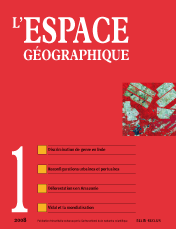

Spatial patterming of gender discrimination in India. Impact of social and geographical distances (6 fig., 1 tabl.)
This paper offers a systematic exploration of the geography of child sex ratio in India. Mapping sex ratio on a micro-scale provides a starting point to assess its geographic patterning, followed by a geostatistical analysis of spatial dependence. The impact of distance on variations in levels of discrimination towards girls is then confronted with a comparable measurement based on socio-economic distance. The comparative analysis of the effects of social or space distance shows that geographical patterning plays a major role in regional variations in discriminatory behavior observed in contemporary India.
keywords: DIFFUSION, DISCRIMINATION, GENDER, INDIA, DISTANCE, SEX RATIO
Towards a new urban form? Suburbanisation and diffusion of employment in the Montreal metropolitan region (5 fig., 3 tabl.)
This paper explores various processes that may organise the suburbanisation of economic activity, by way of a study of employment in the Montreal metropolitan region over the 1996-2001 period. It tests the idea that the Central Business District is losing its command functions to suburban employment centres, and the idea that employment growth is scattered haphazardly across the metropolitan area. The authors conclude that in Montreal accessibility, agglomeration and centrality continue to guide the location of new jobs. The idea that new processes are guiding the location of economic activity does not, therefore, seem to be generalisable to all cities.
keywords: CENTRALITY, EMPLOYMENT, INFRASTRUCTURE, SUBURBANISATION, MONTREAL
Urban design and perceptions of the district. The example of Bellevue (Saint-Étienne) (1 fig., 6 photos, 1 tabl.)
The type of restructuring of traditional working-class districts and the new forms they give rise to are partly linked to the political and social conditions underpinning the transformation of these areas. This concept can be observed in Bellevue, a former workingclass suburb south of Saint-Etienne’s centre, singled out for an infrastructure and enhancement project. The uncommon cohabitation between the working-class and middle class residents was strengthened and their federative perceptions asserted.
keywords: DISTRICT, REPRESENTATION, SOCIAL RESTRUCTURING, URBAN DESIGN
A spatial approach to the issue of ports: a proposal for a geographical survey of European hinterland. (1 encadré, 2 fig., 3 tabl.)
The concept of port hinterland is given a fresh interpretation against the backdrop of the globalisation of practices of transport and logistics operators. The development of global networks could be expected to alter the relationship between the points on networks and their areas of influence. This article tests the inverse hypothesis, i.e. that conventional distances are a permanent feature in the composition of hinterlands. Complex globalised new practices that have simple spatial consequences (distance, polarisation, hierarchisation) is the paradox examined in this exercise applied to the French hinterlands of Western European ports.
keywords: COMPETITIVE SPACE, DISTANCE, PORT GEOGRAPHY, HINTERLAND, STRUCTURE
Amazonian landscapes and pioneer frontmonitored by remote sensing: the case of Mato Grosso (7 fig., 6 images, 1 tabl.)
Remote sensing makes it possible to quantify the extent of the clearings in the Brazilian Amazon. The diversity of sensors also enables a multi-scale approach to the landscapes of Mato Grosso, while pinpointing the respective role of the actors in deforestation: large stockbreeders, small settlers, and farmers integrated into the soy, cotton or sugarcane agro-business. The landscapes, originally very different, are moving towards a single type where forest occupies only a tiny area (reserves, ancillary forests) in the middle of pasture or cultivated fields.
keywords: AMAZONIA, LANDSCAPE, PIONEER FRONT, REMOTE SENSING
An unexpected geography. Paul Vidal de la Blache’s world system (3 fig.)
Olivier Dollfus, with his “système Monde” was not the first French geographer to represent the world as a system. Other geographers, like Paul Claval and Alain Reynaud, have also taken a systemic approach in their analyses of the world. However, there were geographers who, as early as the turn of the 20th century, had already developed a view of the world as a finite, complete and, in a way, systemic or systematic totality. Among them was Paul Vidal de la Blache, who focused on the installation of a world communication network and the emergence of three major economic poles, which were interdependent although in competition and unequal: Europe, the United States and the Far East.
keywords: COMMUNICATION NETWORK, GLOBALISATION, PAUL VIDAL DE LA BLACHE, WORLD SYSTEM
Book reviews
In this issue of l’Espace géographique, you will find critical reviews of the following books
DELER J.-P., MESCLIER É. (2004). Los Andes y el reto del espacio mundo: homenaje a Olivier Dollfus. Lima: Institut français d’études andines (IFEA), Instituto de estudios peruanos (IEP), Embajada de Francia en Lima, 419 p. (Anne-Laure AMILHAT-SZARY, université de Grenoble)
DE KONINCK R. (2006). Singapour, la cité-État ambitieuse. Paris: Éditions Belin, coll. «Asie plurielle», 176 p. (Michel BRUNEAU, CNRS Bordeaux)
ROSIÈRE S. (2006). Le Nettoyage ethnique, terreur et peuplement. Paris: Ellipses, 300 p. (Philippe PELLETIER, université de Lyon 2)
ROBIC M.-C. (coord.), MENDIBIL D., GOSME C., ORAIN O., TISSIER J.-L. (2006). Couvrir le monde, un grand XXe siècle de géographie française. Paris: ADPF-ministère des Affaires étrangères, 232 p. (Claude BATAILLON, CNRS Toulouse)
BLAIS H. (2005). Voyages au Grand Océan. Géographies du Pacifique et colonisation (1815-1845). Paris: CTHS, 351 p.
BLAIS H., LABOULAIS I. (2006). Géographies plurielles. Les sciences géographiques au moment de l’émergence des sciences humaines (1750-1850). Paris: L’Harmattan, coll. «Histoire des sciences humaines», 349 p.
FROLOVA M. (2006). Les Paysages du Caucase. Invention d’une montagne. Paris: CTHS, 206 p.
FORÊT Ph. (2004). La Véritable histoire d’une montagne plus grande que l’Himalaya. Paris: Bréal, 287 p. (Bernard DEBARBIEUX, université de Genève)
L’espace géographique 4/07![]()
![]() L’espace géographique 2/08
L’espace géographique 2/08
For subscribe or buy this issue: BELIN
![]() L’Espace géographique: contents
L’Espace géographique: contents
Last modified: June 19, 2008